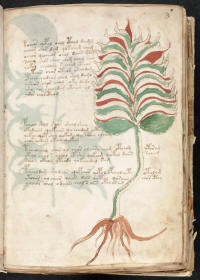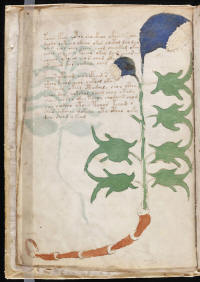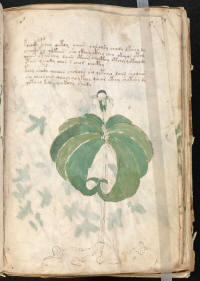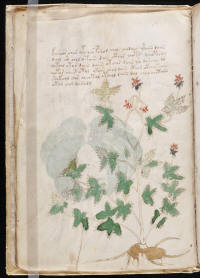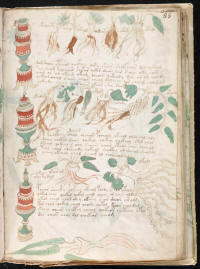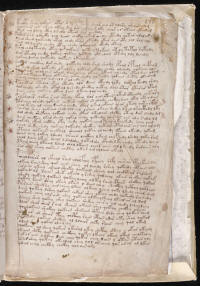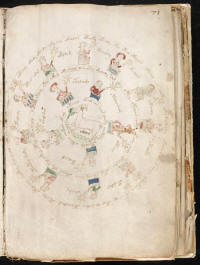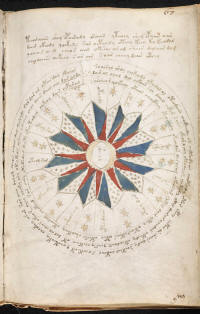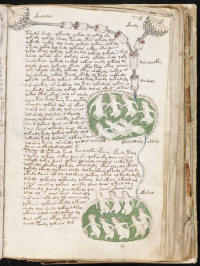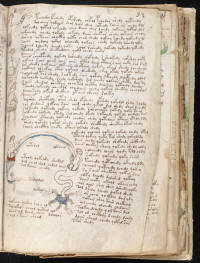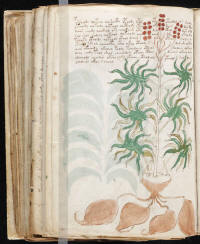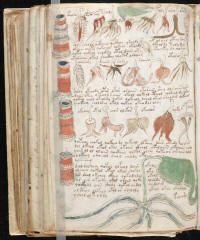|

by Aldrich Daimler
from
BorderLands Website
The intelligent
reader will judge for himself. Without examining the facts fully and
fairly,
there is no way of
knowing whether vox populi is really vox dei, or
merely vox asinorum.
Cyrus H. Gordon
from Riddles in
History
INTRODUCTION
Contemporary and Not So Contemporary Cryptography
It is always unfortunate to find another science which has fallen
prey to the whims of the so-called "schools of thought".
Unfortunately, it would appear that the science of Cryptography has
become their latest victim, and seems to be directly linked to the
introduction of the computer, and the use of its ability to perform
"complex calculations". Let us not forget, that the science of
Cryptography is not a science of numbers, but one of
words.... symbols. Written language is cryptography in its purest
sense. It follows no laws or rules as does the science of
mathematics. It is creative and spontaneous.
The ancient scribes
with their acrostic-telestic inscriptions, anagrams, and bi-literal
ciphers (to name but a few methods used) realized that the purest
cipher was one that was not revealed as a cipher. These ancient
scribes were certainly as intelligent if not more so than we
consider ourselves today, and manipulated language so deftly that it
often takes modern scholars a long time to grasp the presence, let
alone all the subtleties, of ancient riddles. These ancient "steganographers"
utilized their creative art to conceal the messages of their day.
Today’s "encryption" schemes with all their lifeless algorithms are
not the engines of ingenuity they claim to be, but are merely
simplistic number scramblers. They may have their purpose in the
transmission of data, but the messages they render unintelligible
disclose the fact that they contain concealed information, and hold
no value aesthetically as far as cryptographic writing is concerned.
There simply is no vision in creating machines that spew forth
deluges of riffled characters. Of course, the cryptographic
orthodoxy would reel at this statement as they try ever harder to
find the perfect algorithm, or struggle with the endless factoring
of streams of numbers. Their view is toward unification and adoption
of standards in the cryptographic sciences, thus putting to rest any
sense of creative vision.
The true art of Steganography (a method by which a message can be
disguised by making it appear to read or be something else) is one
such creative form of cryptography that has been lost (some methods
still exist) and seems to have gone the way of most secrets of
ancient knowledge. A classic example of this lack of vision by the
"authorities" in cryptography is their detraction of William Romaine Newbold’s decipherment of the
Voynich Manuscript. There are many
reasons, which will be detailed here, why many had derogated Newbold’s findings. For instance, if
Newbold’s assertions were
correct, scientific history would have to be re-written. Such is the
importance of this most incredible document. In the following pages
I shall not only give a detailed history of what has been referred
to as the "most mysterious manuscript in the world", but will show
that Newbold most likely did solve the cipher of the Voynich
manuscript, and was probably the only one of his day qualified to do
so.
HISTORY OF THE VOYNICH MANUSCRIPT
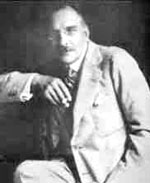 In order to understand the nature of this undertaking it is
necessary to describe the Voynich manuscript (hereinafter referred
to as "MS") and detail its most curious history. The
Voynich MS is
so named after Wilfrid M. Voynich, a well known bibliophile from New
York. In 1912, during one of Mr. Voynich’s many visits to Europe in
quest of old and rare books, he came across a remarkable collection
of precious manuscripts. These volumes had been buried in a chest
and remained hidden inside a castle in Southern Italy for decades.
While he was perusing the manuscripts for purchase, his attention
was particularly drawn to one odd, out of place looking bundle. In order to understand the nature of this undertaking it is
necessary to describe the Voynich manuscript (hereinafter referred
to as "MS") and detail its most curious history. The
Voynich MS is
so named after Wilfrid M. Voynich, a well known bibliophile from New
York. In 1912, during one of Mr. Voynich’s many visits to Europe in
quest of old and rare books, he came across a remarkable collection
of precious manuscripts. These volumes had been buried in a chest
and remained hidden inside a castle in Southern Italy for decades.
While he was perusing the manuscripts for purchase, his attention
was particularly drawn to one odd, out of place looking bundle.
Examination revealed the MS to be written entirely in cipher. Even a
brief inspection of the vellum upon which it was written, the
calligraphy, the drawings, and the pigments suggested its date of
origin as the latter part of the thirteenth century. It was not
until some time after Mr. Voynich purchased the MS that he read the
document attached to the front cover bearing the date1665 (or 1666).
It is a letter from Joannes Marcus Marci, rector of the University
of Prague, to Athanasius Kircher, a Jesuit scholar, presenting the
MS as a gift to Kircher. Its most important significance can be seen
from the following translation of it:
|
REVEREND AND DISTINGUISHED SIR, FATHER IN CHRIST:
This book, bequeathed to me by an intimate friend, I destined
for you, my very dear Athanasius, as soon as it came into my
possession, for I was convinced it could be read by no one except
yourself.
The former owner of this book asked your opinion by letter,
copying and sending you a portion of the book from which he
believed you would be able to read the remainder, but he at that
time refused to send the book itself. To its deciphering he devoted
unflagging toil, as is apparent from attempts of his which I send
you herewith, and he relinquished hope only with his life. But his
toil was in vain, for such Sphinxes as these obey no one but their
master, Kircher. Accept now this token, such as it is and long
overdue though it be, of my affection for you, and burst through its
bars, if there are any, with your wonted success.
Dr. Raphael, tutor in the Bohemian language to Ferdinand Ill,
then King of Bohemia, told me the said book had belonged to the
Emperor Rudolph and that he presented to the bearer who brought
him the book 600 ducats. He believed the author was Roger
Bacon, the Englishman. On this point I suspend judgment; it is
your place to define for us what view we should take thereon, to
whose favor and kindness I unreservedly commit myself and
remain,
At the command of your Reverence,
JOANNES MARCUS MARCI,
of Cronland.
PRAGUE, 19th August, 1665 (or 1666). |
The key, here, is that the un-named "bearer" believed the author was
Roger Bacon, the 13th century Franciscan monk, philosopher,
magician, and alchemist. Bacon had been persecuted for his writings
and scientific discoveries, and referred in his works to the
necessity of hiding his great secrets in cipher. This emphasis on
Roger Bacon’s authorship will become clear in later development. One
should not confuse Roger Bacon with the Renaissance figure
Francis
Bacon (F. Bacon was also quite prolific on ciphering techniques) The
testimony in the letter of Dr. Raphael, that the MS was once in the
possession of Emperor Rudolph is fairly determinative. The signature
of Jacobus de Tepenecz found inside the MS confirms the fact that
the MS found its way to the Emperor’s court, as de Tepenecz was
ennobled and befriended by the Emperor in 1608, and lived at his
palace.
Further investigation by Mr. Voynich revealed that the MS had been
in the possession of Dr. John Dee, the 16th century astrologer and
magician. Dee had spent the years between 1584 and1588 at Rudolph’s
court as a secret agent of Queen Elizabeth I, and probably brought
the MS to Prague. Dee was an admirer of
Bacon and collected many of
his works (a catalogue of Dee’s library prepared in 1583 enumerates
thirty-seven works of Bacon). Sir Thomas Browne, the inventor of the
English word ’cryptography’, claimed that Dee’s son
Arthur had
spoken to him about a ’book containing nothing but hieroglyphiks,
which book his father bestowed much time upon, but I could not hear
that he could make it out’.
If we are to go back any further we might speculate that Dee
obtained a good portion of his Bacon collection from the
Northumberland family. It is known that Dee was closely associated
with the Duchess of Northumberland, and that the Duke of
Northumberland received the spoils from the dissolution of
monasteries that began around 1538. It is presumed that from these
spoils, the Duke (or more likely the Duchess) of Northumberland
presented Dee with the MS.
A BRIEF SKETCH OF THE CONTENTS OF THE VOYNICH MS
The Voynich MS is a small quarto averaging about 6 by
9inches. The MS now contains the equivalent of 246 quarto pages, but
may have originally contained not less than 262 pages. 33pages
contain text only, 212 with text and drawings, and the last page
contains the Key. The text is written in an enciphered script, and
the drawings are colored in red, blue, brown, yellow, and green. The
contents of the MS are divided up into 5categories. The first and
largest section contains 130 pages of plant drawings with
accompanying text, and is called the Botanical division. The second
contains 26 pages of drawings, obviously astrological and
astronomical in nature. The third section contains 4 pages of text
and 28 drawings, which would appear to be biological in nature.
The fourth division contains 34 pages of drawings, which are
pharmaceutical in nature. The last section of the MS contains
23 pages of text arranged in short paragraphs, each beginning with a
star. The last page (the 24th of this division) contains
the Key
only.
VOYNICH AND NEWBOLD
After considerable historical research, Mr. Voynich submitted the
MS
to several cryptographers. When the symbols in the MS had been
copied and classified, their appearance and frequency were found to
be consistent throughout, and seemed to have been composed in a
single-alphabet substitution cipher. But, this did not appear to be
the case, much to the dismay of the cryptographers, and they could
not extract an intelligible message in any language from the text.
The MS was then surrendered to several botanists and astronomers
(due to the nature of the drawings) and to many experts in ancient
languages— all to no avail. Realizing the possibility that the
MS
might require the interpretation of someone versed in cabalistic
lore (Roger Bacon was no stranger to this) Voynich finally turned
over the MS to Dr. William Romaine Newbold, of the University of
Pennsylvania, and one of the greatest students of medieval
philosophy and science. Newbold possessed the advantage that he was
familiar with medieval methods of thought, was versed in occult
sciences, and, he was also a cryptographer. Newbold started work on
deciphering the Voynich MS in 1919.
NEWBOLD’S DECIPHERMENT WITH SOME CONCLUSIONS
When Newbold first attacked the MS for decipherment, he realized
that he needed to find a key which would allow him to understand how
the MS was enciphered. On the
last page of the MS was written a
single sentence:
"michiton oladabas multos te tccr cerc portas"
Disregarding the obvious nulls used in the sentence (ton ola tetccr
cerc) and exchanging the "o" in "multos" for "a", the intelligible
Latin sentence emerges:
"michi dabas multas portas"
translating into English,
"To me thou gavest many gates."
Counting the number of letters in the sentence reveals it to be 22.
Newbold then adapted the Latin alphabet to it omitting the letter
"k", replacing "x" with "v" and produced the first form of the
cipher alphabet used by Bacon:
m i c h i d a b a s m u l t a s p o r t a s
a b c d e f g h i l m n o p q r s t u v y z
Here is what makes Newbold’s qualifications for decipherment of the
MS so felicitous. Newbold understood that a major clue was to be
found in the word "portas", in that its interpreted cabalistic
meaning of "gates" would be the secret to the clarification of
the
Key. Newbold knew that Bacon was well acquainted with
the Cabala and
would have used such a plan in his Key, for in Bacon’s Epistle on
the Nullity of Magic, where he details several ciphering systems,
the sixth such system is called, "The Kabbalah of the Nine
Chambers".
From Newbold's footnotes we find
the following:
|
"In Cabalistic philosophy the universe consists of God’s
thought; thought is expressed in speech; speech is composed of
letters; hence the Letters are the ultimate constituents of Things.
The ’’gates" are the 231 biliteral combinations of the Hebrew
Ietters (doubles omitted; 231 permutated pairs added by later
writers); they represent the primary combinations of the highest
manifestations of the divine Being which are at once the forces
which make other things, the material of which they are made, and
the channels through which the divine energy streams forth into
the lower world. A single quotation from the Sepher Yezirah, will
suffice:
He combined (the Letters), weighed them, exchanged them,
Aleph with all and all with Aleph,
Beth with all and all with Beth,
and they go (each) all the way around (the Alphabet). And they are
found (comprised) in 231 gates, and everything formed and
everything uttered is found to proceed from one Name."
|
Thus, "gates" not only implies a cipher of many steps, but it
reveals that the gates are the channels through which alphabetic
values are conveyed from Key Sentence to the 484 (admitting doubled
letters) biliteral symbols.
With the Key now in hand, Newbold began to approach the actual text
of the MS. With more cabalistic associations appearing,
Newbold
discovered 22 distinct symbols, among these 22 were recognized the
15 signs that composed the Greek system of shorthand.
Bacon was
quite familiar with this Greek system, having written a grammar
including such information, and reading from the eighth chapter of
Bacon’s Epistle on the Nullity of Magic, we will find the great
significance he placed on secret writing, and particular reference
to the shorthand system:
|
"The man is insane who writes a secret in any other way than one
which will conceal it from the vulgar and make it intelligible only
with difficulty even to scientific men and earnest students. On this
point the entire body of scientific men have been agreed from the
outset, and by many methods have concealed from the vulgar all
secrets of science. For some have concealed many things by
magic figures and spells, others by mysterious and symbolic
words. For example, Aristotle in the Book of Secrets says to
Alexander, ’O Alexander, I wish to show you the greatest secret of
secrets; may the Divine Power help you to conceal the mystery
and to accomplish your aim. Take therefore the stone which is not
a stone and is in every human being and in every place and at
every time, and it is called the Egg of the Philosophers, and
Terminus of the Egg.’
Innumerable examples of the kind are to be
found in many books and divers sciences, veiled in such
terminology that they cannot be understood at all without a
teacher. The third method of concealment which they have
employed is that of writing in different ways, for example, by
consonants alone, so that no one can read it unless he knows the
words and their meanings. In this way the Hebrews and the
Chaldaeans and Syrians and
Arabs write their secrets. Indeed, as
a general thing, they write almost everything in this way, and
therefore among them, and especially among the Hebrews.
Important scientific knowledge lies hidden. For Aristotle in the
book above mentioned says that God gave them all scientific
knowledge before there were any philosophers, and that from the
Hebrews all nations received the first elements of philosophy....
In the fourth place, concealment is effected by commingling letters
of various kinds; it is in this way that Ethicus the astronomer
concealed his scientific knowledge by writing it in Hebrew,
Greek,
and Latin letters in the same written line. In the fifth place,
certain
persons have achieved concealment by means of letters not then
used by their own race or others but arbitrarily invented by
themselves; this is the greatest obstacle of all, and Artephiushas
employed it in his book On the Secrets of Nature. In the
sixth
place, people invent not characters like letters, but geometrical
figures which acquire the significance of letters by means of
points and marks differently arranged; these likewise Artephius
has used in his science. In the seventh place, the greatestdevice
for concealment is that of shorthand, which is a method of noting
and writing down as briefly as we please and as rapidly as we
desire; by this method many secrets are written in the books of the
Latin-using peoples.
I have thought fit to touch upon these
methods of concealment because I may perhaps, by reason of the
importance of my secrets, employ some of these methods, and it
is my desire to aid in this way, at least you, to the extent of my
ability." |
The other 7 shorthand signs of Newbold’s discovery all fit the same
general character of the first 15, and were used by Bacon to fill
out the Greek shorthand, which was lacking expression.
Newbold continued by employing the biliteral method to the converted
shorthand, and found that frequency analysis of the resultant
alphabet revealed it to be characteristic of Latin. The final stage
in the process of decipherment was the anagramming process. The
process of anagramming texts was probably the most popular method of
the day used for concealing messages, and the necessity of
concealment was due to political or ecclesiastical reasons of the
time, making the information unpropitious for pronouncement. It is
known that the Cabalists were professed anagrammatists, and the
third part of their art – themuru (changing) dealt with
transposition and recombination of the letters of words for mystical
interpretation. The fact that it was also a tradition among the
"orders" can be witnessed in the works of von Bingen, and certainly
in the Abbe N. De Montfaucon De Villars’ "Comte De Gabalis" (Quodtanto
impendio absconditur etiam solummodo demonstrare destruereest -
Tertullian). It was even continued with the likes of Galileo (Haec
immatura a me jam frustra leguntur - oy), Tycho Brahe (who also was
at the court of Rudolph), Johannes Kepler, and many others.
At last, the plain text began to emerge, and without going too far
afield for the letters of anagrammed text. The letters to be
rearranged occurred in pairs next to one another, either indirect or
reverse order, and only relatively infrequently did Newbold
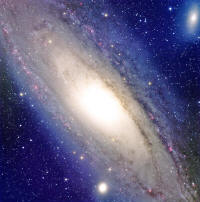 have to
go as far as three or four words ahead in order to fill in the
plaintext. have to
go as far as three or four words ahead in order to fill in the
plaintext.
What
Newbold discovered in the text was absolutely astonishing—
enough to gather a lot of attention from the scientific community.
The biological drawings in the text were described asseminiferous
tubes, the microscopic cells with nuclei, and even
spermatozoa.
Among the astronomical drawings were the descriptions of spiral
nebulae, a coronary eclipse, and the comet of 1273. One of the more
baffling things about this was that many of the drawings of plants,
and of the galaxies appeared to have been invented.
There was no
doubt that if Bacon were the author of such a text, he must have had
some way of obtaining the information. For instance, Newbold’s
translation of the caption near the drawing of the nebula of
Andromeda - click image left (which clearly shows its spiral characteristics), gave its
location by the following:
|
"In a concave mirror I saw a star in the form of a snail.... between
the
navel of Pegasus, the girdle of Andromeda, and the head of Cassiopea".
|
Now, Bacon is credited with the invention of the
magnifying glass,
but it should be certain that he did not invent the telescope or the
microscope as many at the time of this discovery conjectured. The
"concave mirror" is probably the single most important clue here.
Many of the later prominent Renaissance figures would not only
describe similar visions of travel to distant places, several also
included such "shewstones" as their viewing apparatus. In the works
of Dee, Kircher, and even the more famous Nostradamus, one will find
reference to such a device, and in each case these individuals
recorded the experience of visions associated with it. Some of their
descriptions were later proven to be precise. The actual knowledge
pertaining to the use of a device such as this is probably now lost,
but in any case it is most worthy of mention considering the
circumstances. Let us now turn to some of the objections to Newbold’s decipherment of the MS.
NEWBOLD’S DETRACTORS - AND HIS VALIDATION
Initially, upon the announcement of his findings in1921, Newbold
received some praise for his work. Even John M. Manly, a military
intelligence cryptanalyst, wrote a favorable review in Harper’s
Magazine. But, this was not to last very long, and soon the attacks
proceeded. The first of such attacks came from research chemists who
stated that the rough vellum surface upon which the MS was written
had caused the ink to break up into spots and shadings with age.
This break up of characters, they stated, was what Newbold had
actually seen when deciphering the shorthand characters.
This criticism that the ink had merely broken up into spots and
shadings due to age was unfounded due to the fact that many
documents nearly as aged as the Voynich MS, with comparable ink, do
not display cracking similar to the individual characters in the MS.
Also, if the arrangement of characters was due to this breaking up
of the ink, certainly more than 22 individual shorthand symbols
would have been discovered by Newbold.
The next attack was concerned with the biliteral method of
Newbold’s
decipherment. Cryptographers stated that by Newbold’s methods,
Bacon
could not have enciphered the text to begin with. But, Newbold
clearly detailed the enciphering process, and revealed that Bacon
did not use "orthodox" methods of enciphering to which the
cryptographers were accustomed.
Attacked most heavily of all was the anagramming process Newbold
used. These detractors maintained that one could anagram any text
into anything one chose, and that this method would not have
followed the qualifications of a "good" cipher, in that the first
quality of any "good" cipher is that it must convey its message with
absolute certainty. Newbold’s anagramming process did NOT use
"blocks of 55 to 110 characters", as had been put forth by these
detractors, on the contrary, it can be shown from his own notes that
he was very careful in his observations:
|
"The only indication that the recomposition is correct is the
regular
appearance, at intervals of NOT more than three or four words, of
letter groups suggesting words appropriate, in syntax and logic, to
the preceding text. If they fail to appear, if one is driven to
arbitrary choice in order to make sense, the recomposition is
probably wrong." |
I have observed this misrepresentation of facts of
Newbold’s
decipherment in a number of works (David Kahn’s gigantic work titled
The Codebreakers immediately comes to mind) and find it quite an
admonition to any other statements made by such authors. The fact
that his detractors used such methods to anagram texts into any
messages they seemed fit — designed to expose flaws in Newbold’s
decipherment — is clearly disinformation. Newbold, by HIS method,
equally tried other texts of the period including works of Bacon
which were not meant to be in cipher, and while he could form Latin
words for a time, he was soon left with unmanageable groups of
consonants, and discontinued the experiment, as Latin requires
between 40 and 50 percent vowels.
It wasn’t until after Newbold’s death in 1926 that more serious
assaults would come. In 1931 John Manly (who earlier gave praise)
published a 47 page article in Speculum Magazine of what he called
"a detailed analysis" that attempted to make Newbold’s work seem
entirely worthless. But many more would hinge their deprecations on
Newbold’s interpretation of the drawings contained in the MS. Most
said that the biological pictures were cabalistic (they certainly
were!), symbolical, vague, and capable of various interpretations. I
must note that I personally have given these biological drawings to
persons well credentialed in the field of Biology, and asked them to
give me an explanation of what they see in them. In every instance,
and without any prior knowledge of the MS, they have given
descriptions that very closely resemble the deciphered
interpretations of Newbold.
Other assailants made particular note of the drawing that
represented the nebula Andromeda. Based on the fact that the
spiral
nebula in Andromeda lies edge on to earthly observers, Bacon would
have had to have an incredibly powerful telescope to view such a
thing. But, as we have noted, no one was really claiming that he
did.
It may be deduced from these painstaking onslaughts that maybe these
assailants felt it was necessary to hide the true nature of the
work. In Manly’s 1931 article, he blatantly reveals his real
concerns with the warning to all that, "these results (of Newbold’s)
threaten to falsify to no unimportant degree, the history of human
thought." Kahn, in The Codebreakers, devotes several pages to the
MS
decipherment, and groups Newbold into a category he later describes
as oddballs and lunatics who believe in such things as water
witching.
Of course, the depreciated Newbold decipherment did not discourage
others from attempting to figure out the MS, and a few of the
arguments put forward may have been somewhat conceivable. In 1944,
Professor Hugh O’Neil, a botanist at the Catholic University of
America, offered evidence that the MS could not have been written
before 1493. He observed that the drawings in the MS include the
likes of the common sunflower, and Capsicum, both plants native to
the Americas which according to him, were unknown to Europeans
before the return of
Columbus from his second voyage. We needn’t go
into the Columbus discovery here, as historically it is well known
that he was hardly the first to venture to the Americas.
Not long after O’Neil’s observations, Dr. Leonell Strong, a cancer
research scientist and amateur cryptographer, took on the project of
deciphering the MS. Fancifully boasting that he could "unravel" the
secret of any cipher, Strong said that the solution to the
MS cipher
was a "peculiar double system of arithmetical progressions of a
multiple alphabet". Even here, there was a great similarity to
Newbold’s system, but Strong altogether bombastically stated that
the plaintext revealed the MS to be written by the 16th century
English author Anthony Ascham, whose works include A Little Herbal,
published in 1550. Although the MS does contain one section
resembling an herbal, it is unknown where the author of A Little
Herbal would have obtained such literary and cryptographic
knowledge.
The speculation of William F. Friedmann, another military
cryptographer, was that the MS was actually a text in an artificial
language, and may have held some merit if it were not for the fact
that he was also responsible, and instrumental in the demolition of
Newbold’s theory (again, after Newbold’s death). But, he, too never
went any further than this simple hypothesis. Many others have
invented their own versions of decipherment of the MS, but all of
them fall short of making anything intelligible out of the
mysterious characters. To the cryptographic orthodoxy, the MS is
still "undeciphered". I believe many have merely taken the
disparaging words of others as proof that the Newbold solution is
bogus, without actually examining the specifics. Had Newbold been an
amateur with nothing but this decipherment for credentials, it would
certainly raise some doubt.
But, Newbold indeed practiced his
techniques on similar manuscripts such as the Tironian signs of the
so-called Vatican Document (which I won’t detail here as it would
necessitate the space of an entire article in itself) and many
others. It is most probable though, that the Voynich MS actually
cost Newbold his health, both physically and mentally. In the latter
days of his work on the MS he began to grow weary and would often
restructure his entire method without any sense of reason. Still,
the heart of Newbold’s inspiration lies in his initial work on the
MS, and there has not been anyone since who has even come close to
the original genius of his solution to "the most mysterious
manuscript in the world".
Some full-page illustrations of
the MS (click images to
enlarge)
|
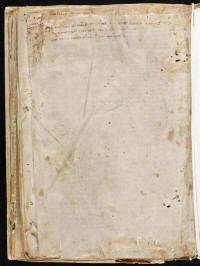 |
|
Description
Text-only page
This page contains the famous lines of extraneous
writing which have inspired many researchers of the
Voynich MS. At the very top edge there is some
writing in a tiny script. It can barely be made out.
Below that, and in a larger script, there are three
lines in what appears to be a mixture of Latin, German
and Voynich script.
It has been
faithfully reproduced by
>>
IMAGE: Jorge Stolfi |
MORE INFORMATION
REFERENCES
1. The Cipher of Roger
Bacon by William Romaine Newbold, edited by Roland Grubb
Kent. University of Pennsylvania Press, 1928.
2. Secret and Urgent -The Story of Codes and Ciphers
by Fletcher Pratt. Blue Ribbon Books, 1942.
3.
The Secret Teachings of All Ages by Manly Palmer Hall.
Philosophical Research Society, 1977.
4. Cryptography - The Science of Secret Writing by
Lawrence Dwight Smith. W.W. Norton, 1943.
5. Opus Majus by Roger Bacon. Complete Latin version
by Howard R. Bayne, 1946.
6. Comte De Gabalis by the Abbe N. De Montfaucon
DeVillars. Paris 1670.
7. "The Incredible Roger Bacon" by Manley Mills.
Fate, April 1951, pp 69-72.
8. "Cipher of the Secret Book" by Betty McKaig
(Interview with Leonell Strong). North County Independent,
Oct. 7, 1970.
9. "The Insignificant Cry of Roger Bacon" by Malachi
Martin. Intellectual Digest, August, 1972. pp 52-55.
10. "Codes and Ciphers" by Peter Way – Encyclopedia
of Espionage, Aldus Books London, 1977.
11. Oddities and Curiosities of Words and Literature
by C. C. Bombaugh. J. B. Lippincott, 1890.
12. Riddles in History by Cyrus H. Gordon. Crown
Publishers, 1974.
13. A True and Faithful Relation of What Passed for
Many Years Between Dr. John Dee... and Some Spirits. Edited
by Meric Casaubon. London, 1659.
14. The Hieroglyphic Monad by Dr. John Dee translated
byJ. W. Hamilton-Jones. Neil & Co. Edinburgh, 1947.
15. The Curious Lore of Precious Stones pp 188-196
16. The Codebreakers by David Kahn. McMillan Co.,
1967.
|

 In order to understand the nature of this undertaking it is
necessary to describe the Voynich manuscript (hereinafter referred
to as "MS") and detail its most curious history. The
Voynich MS is
so named after Wilfrid M. Voynich, a well known bibliophile from New
York. In 1912, during one of Mr. Voynich’s many visits to Europe in
quest of old and rare books, he came across a remarkable collection
of precious manuscripts. These volumes had been buried in a chest
and remained hidden inside a castle in Southern Italy for decades.
While he was perusing the manuscripts for purchase, his attention
was particularly drawn to one odd, out of place looking bundle.
In order to understand the nature of this undertaking it is
necessary to describe the Voynich manuscript (hereinafter referred
to as "MS") and detail its most curious history. The
Voynich MS is
so named after Wilfrid M. Voynich, a well known bibliophile from New
York. In 1912, during one of Mr. Voynich’s many visits to Europe in
quest of old and rare books, he came across a remarkable collection
of precious manuscripts. These volumes had been buried in a chest
and remained hidden inside a castle in Southern Italy for decades.
While he was perusing the manuscripts for purchase, his attention
was particularly drawn to one odd, out of place looking bundle.

